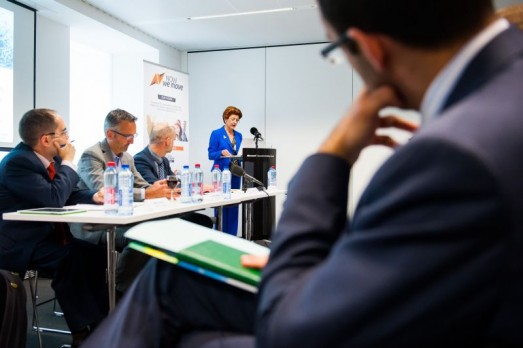“Our product is physical activity”: EU Commissioner and industry experts on the corporate power of physical activity at ISCA debate
30/06/2014

Photo: Hill+Knowlton.
"We are very different from the corporate sector, but we think this diversity gives us food for thought.” With these words, ISCA President Mogens Kirkeby set the scene for a lunch debate hosted by ISCA in Brussels this June, which brought the grassroots sport sector, the European Commission and industry experts together to discuss why physical activity is a valuable product that can be just as good for business as it is for health and wellbeing.
Kirkeby, European Commissioner Androulla Vassiliou, Coca-Cola Europe Corporate Responsibility Director Wouter Vermeulen and Loughborough University Lecturer in Sports Management and Policy Borja Garcia took to the panel after Commissioner Vassiliou gave a keynote speech highlighting the value of cross-sector partnerships that promote sport and physical activity.
“From an EU policy perspective, the latest Eurobarometer report confirms the importance of supporting member states in promoting sport and physical activity and clearly shows the need to pursue efforts at all levels for a healthier Europe,” the Commissioner said, referring to the EU’s latest survey on sport and physical activity participation in Europe, which revealed little change in participation levels since 2009.
Companies are already grasping opportunities to promote health-enhancing physical activity through their brands. Coca-Cola is a prime example of a company that has shifted its focus from elite sport to mass participation sport and physical activity in recent years. Vermeulen emphasised why corporations like Coca-Cola are turning their attention help their consumers enjoy the benefits of an active lifestyle.
“We need sustainable societies, we need healthy societies, we need happy societies for business to flourish and that’s why we are engaged in active lifestyle,” he said, elaborating on some of the considerations Coca-Cola has made as a global beverage giant to follow this path.
“One of our core assets is, of course, the strength of our brand. So how can we, in a credible way, leverage the brand Coca-Cola to promote moving more, or to ensure that moving is something fun and enjoyable instead of something that you have to do or a barrier?”
This keyword, “barrier”, was a recurring theme in the panellists’ discussion. In particular, they exchanged ideas from a business perspective about how businesses can overcome the employees’ biggest barrier to engaging in physical activity, according to the latest Eurobarometer survey – time.
The panel’s higher education representative, Garcia, who is based in the UK, noted that there is a growing divide between physical activity and daily work, which has pushed physical activity into a diminishing window of time away from the office desk.
“Physical activity and sport seems to me to be moving from occupation to leisure time,” he said. “So you can only do sport in your leisure time; you cannot be active in your occupation time.”
Vermeulen stressed the need to create an active workspace to overcome the barrier of decreasing leisure time for physical activity.
“If we want to address this, we will have to integrate physical activity in our everyday routines. How about active transport, walking to school, the built environment? This debate on active lifestyle and sedentarism has so many connection points. That’s why partnerships, and multi-sector partnerships, are so important, because we are not addressing a single issue, we are addressing a systemic change and that’s why so many partners need to be involved.”
Despite coming from four different sectors, from profit to non-profit to governmental to institutional, the panellists agreed that their sectors were on a mission to promote the same product. This poses a unique challenge to them all, as Kirkeby pointed out.
“Our product is physical activity or the benefit of physical activity,” he said. “The biggest problem here for us is that the buyer needs to produce it themselves.”
And what better way to sell this product than with the promotional power of all of these sectors combined?
By Rachel Payne, ISCA
Posted on 30/06/2014 by Rachel Payne, ISCA

